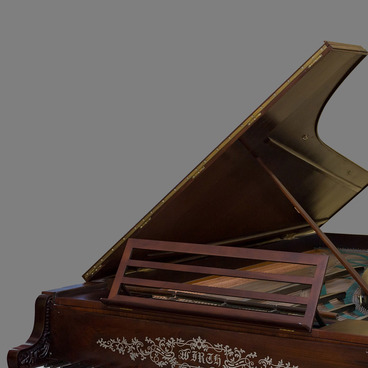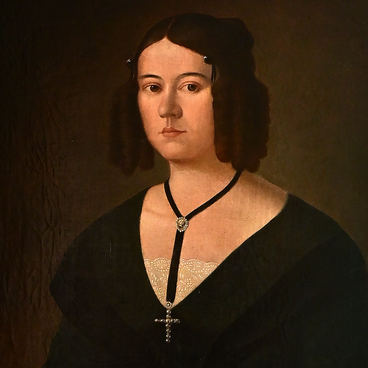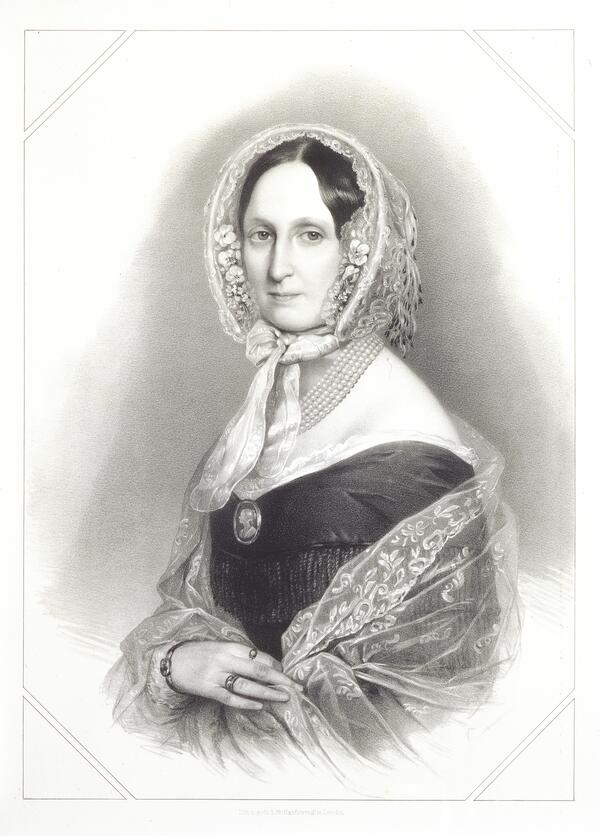The exhibition displays a lithograph made by Austrian artist Josef Kriehuber. It depicts Olga Potocka, (her married name — Naryshkina), with her daughter.
Olga Potocka was the daughter of the Polish Count Stanisław Potocki and the famous adventurer of Greek origin, Zofia Clavone. After the death of her parents, Olga’s older sister Sophia and her husband, General Pavel Kiselyov, took care of her. Elizaveta Vorontsova, the wife of Count Mikhail Vorontsov, also played an important role in Olga’s fate: Olga married Vorontsov’s cousin, General Lev Naryshkin.
The wedding of 22-year-old Potocka and 38-year-old Naryshkin took place in March 1824 in Odessa, where the couple settled after the event. The general, known for his hospitality, hosted great receptions in his house. Olga was very fond of elaborate outfits, went out with pleasure, and conversed lively about fashion. In 1838, she and her daughter accompanied her husband when he needed treatment abroad. The family spent several years in Europe. They lived for a long time in Vienna, Berlin, Munich, and Rome.
Memoirist Filipp Vigel wrote: “Back in the summer in Odessa, I saw famous Olga Potocka. Her beauty was breathtaking, but there was nothing virginal, touching about her; I wondered but did not admire her. She was rather silent, not proud, but also inattentive to those to whom she did not need to talk; she was not so much pensive as absent-minded; and in her very youth, she seemed already armed with great experience. Everything was decided, and she saved her arrows of coquetry to defeat the strongest…”
In February 1846, the only daughter of the Naryshkins, Sophia, depicted in the lithograph, married Count Pyotr Shuvalov. In the same year, General Naryshkin passed away. After his death, Olga settled with her daughter in Crimea, and in the late 1850s went to Paris. She died on October 7, 1861 and was buried in the Père Lachaise Cemetery.
The author of the lithograph, Josef Kriehuber, studied in the Vienna Academy of Fine Arts. In 1826, he began working on a new innovative lithography technique. Kriehuber was the most popular and highly paid portraitist in the Austrian capital, and in 1860 he became a member of the Vienna Academy of Fine Arts.
Olga Potocka was the daughter of the Polish Count Stanisław Potocki and the famous adventurer of Greek origin, Zofia Clavone. After the death of her parents, Olga’s older sister Sophia and her husband, General Pavel Kiselyov, took care of her. Elizaveta Vorontsova, the wife of Count Mikhail Vorontsov, also played an important role in Olga’s fate: Olga married Vorontsov’s cousin, General Lev Naryshkin.
The wedding of 22-year-old Potocka and 38-year-old Naryshkin took place in March 1824 in Odessa, where the couple settled after the event. The general, known for his hospitality, hosted great receptions in his house. Olga was very fond of elaborate outfits, went out with pleasure, and conversed lively about fashion. In 1838, she and her daughter accompanied her husband when he needed treatment abroad. The family spent several years in Europe. They lived for a long time in Vienna, Berlin, Munich, and Rome.
Memoirist Filipp Vigel wrote: “Back in the summer in Odessa, I saw famous Olga Potocka. Her beauty was breathtaking, but there was nothing virginal, touching about her; I wondered but did not admire her. She was rather silent, not proud, but also inattentive to those to whom she did not need to talk; she was not so much pensive as absent-minded; and in her very youth, she seemed already armed with great experience. Everything was decided, and she saved her arrows of coquetry to defeat the strongest…”
In February 1846, the only daughter of the Naryshkins, Sophia, depicted in the lithograph, married Count Pyotr Shuvalov. In the same year, General Naryshkin passed away. After his death, Olga settled with her daughter in Crimea, and in the late 1850s went to Paris. She died on October 7, 1861 and was buried in the Père Lachaise Cemetery.
The author of the lithograph, Josef Kriehuber, studied in the Vienna Academy of Fine Arts. In 1826, he began working on a new innovative lithography technique. Kriehuber was the most popular and highly paid portraitist in the Austrian capital, and in 1860 he became a member of the Vienna Academy of Fine Arts.



